The sun hammered down mercilessly as we climbed aboard our boat and cast off. Another party of anglers were also at the jetty, one wearing a Tee shirt with a legend emblazoned across the back “If you haven’t been there, SHUT UP!” It could be a slogan worth remembering so I made a mental note of it.
We powered smoothly across the limpid expanse of flat water to the far bank, our eyes scanning the lake for fish rolling, the illusion of a breeze supplying the only cool air we would receive for the next 9 hours. It is August, two hours drive inland from the Spanish coastal resorts and there’s talk it could hit 50 degrees today. Bing Crosby’s crooning voice is inside my head.
“Come fish, catfish, swim-a-long here…”
We were fishing the river Ebro near Caspe. Many miles downstream, a monster of a dam has flooded the valley to turn the river into a lake. Water galore in the middle of a scrub desert. This is not tourist Spain. No fish and chips shops, raffia donkeys nor English pubs and thankfully a lack of speakers blasting out the Birdie Song.
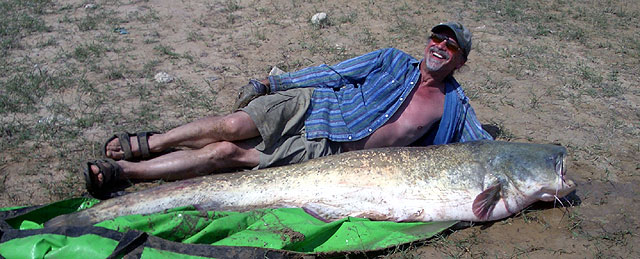
There are however quite a few non-Spanish voices to be heard in the local area. French, German and Dutch voices are common here. Almost all these belong to men; almost all are here for just one reason, and one reason only, they come to catch the giant Wels catfish. Why? Because the Ebro is probably the only place in Europe where an angler has a very high probability of catching a freshwater fish bigger than himself. These are the most powerful fish in our waters, and do they pull! Hook a big one from a boat and expect a tour of the river as the fish tows you downstream. When fishing from the bank you should have a butt-pad/gimbal ready lest a big’un does you a serious mischief.
Back in the mid 1970s a German naturalist (or nature-terrorist, depending on your point of view) decided to introduce catfish into the river Ebro. Without applying for any permission he released just a few dozen in the Mequinenza region. These fish thrived and reproduced in astonishing numbers, sustained on a diet of small stunted carp that in those days infected the system. Today the descendants of those original catfish can be caught in just about every swim on the river, from it’s snow-melt source in the mountains to the flat paella rice paddy-fields of the delta where it enters the Mediterranean east of Tortosa.
It’s many years since my first trip to the river Ebro. In those early days small carp and barbel were the target species. Fishing in the lower reaches of the river, it was common to get a bite every cast and huge catches of 2 to 5lb carp could be made. The area around Amposta was a match anglers dream with the famous chicken factory stretch producing the very best fishing in Europe. If you could stand the stink that is. Then the catfish started to make their presence felt. The small carp became fewer and the barbel all but disappeared. Something was eating them. Something the Spanish call Siluro.
Fishing guides who specialised in catfish started to appear on the river. At first just one or two and then an avalanche of them. Not just Spanish ones either. Over the years I have met French, German, Dutch, Belgian, British and of course Spanish guides. Some of these offer very basic services and others can do five star treatment. All are worth hiring as local knowledge always pays dividends but it is true that some of the guiding services are better than others. Some will drift the lower river with boat-rods and livebaits, some will fish from the banks with multipliers and up-tiders on tripods. Inland, above the dams and on the lakes the catfish can be caught on pellets using stepped up carp-fishing tactics.
The Riba Roja Dam area of the Ebro is world famous in catfish circles. If I ever had to write a book on favourite swims, this stretch would feature high on my list. Back when I used to fish here it was a jungle, and could be a pretty uncomfortable place to fish. If your name is Bear Grylls or Ray Mears perhaps you wouldn’t mind driving out and roughing it even today. But if you are smart and want to avoid rubbing all those sticks together, you can now do it all in comfort utilising the services of budget airlines and the Riverside Lodge at Riba Roja.
The best guides are usually fully booked a long way ahead but in the month of August it’s just a bit too hot and trade is slow so you can often find lower-priced deals and vacancies with even the best outfits. That’s when we decided to go. And, did I mention? It was hot. Bloody hot!
Our party was made up of autumn chickens rather than spring ones. Very accomplished anglers in the main. And me, as the rest of our party would be quick to point out. We were Granddad’s Army in the sun! Our youngest member was barbel supremo Dave Smith at around 54 years young. Next up the ladder would be teacher Neil Depledge, then me, John Founds and Dicky Ogden, closer to seventy than sixty and still chasing fillies. And our oldest member of the party, the angling legend Dave Steuart who celebrated his 80th birthday this year. Not that advancing years or a little sun could ever slow Dave down. Already this year he’s had a carp trip to Canada, a tiger-fish trip to Africa and has another couple of international angling jaunts lined up for later in the year. Our combined years angling experience on this trip was a staggering several hundred years! With this in mind, we chose to go down the easy-option route with a package deal where everything was supplied, rather than as a ‘drive-and-survive’ holiday. We’ve all done those before but this trip we were on holiday and not looking for a mission. It’s about an 18 hr drive from Calais to the Ebro as I remember, so RyanAir got our votes.
For reasons I won’t bore you with, Smiffy and I only had three full days of fishing whilst the others had six. We fished the buddy system, taking turns on the eight catfish rods and two carp rods so it was pure luck who caught the larger fish. The week started slow and progressively got better as the fish got used to the baiting.
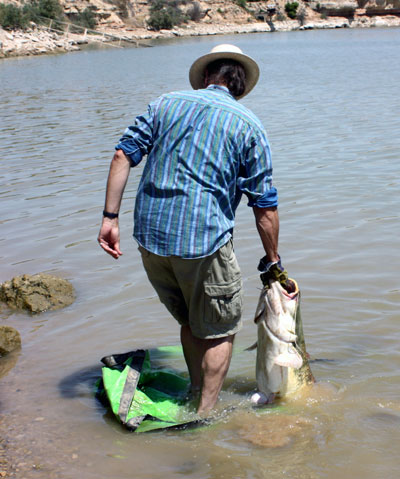
I have a theory. It might be wrong but it makes sense to me. Small catfish are scavengers. The larger catfish are natural predators. Once they reach a certain size they can’t find enough food on the bottom to sustain their huge weights – they have to seek out big, high protein meals, hence they predate on smaller fish. When huge amounts of fishmeal pellets start arriving in piles on the lakebed, they adapt to the circumstances and start to scavenge again, going for the easy pellet meal rather than using lots of energy, chasing small fish. They adapt their feeding patterns to suit the available food source, like everything else in nature. Whatever the reason, the more pellet introduced, the more the catfish feed on them and the more that get caught.
The first day, Monday, was slow fishing with just one catfish of 55lb caught by Dave Steuart and Neil bagging a 28lb carp. Tuesday the score was upped to two catfish. A 58lber to Neil and an estimated 20lb fish to Richard. A bonus 23lb carp fell to me. Wednesday we had three catfish, 41lb to Dave Smith, 25lb to John and a new PB catfish of 150lb to me – which damn near pulled my arms out of their sockets. A couple of carp added spice to the session. By Thursday the swim was picking up. Richard had a 43, Dave Steuart a 38, then John had a 35. A few carp were falling to the carp rods and some carp were also taking the huge catfish pellet baits. We had several between us that day with one very, very nice fish. When the buzzer went off I took the carp rod and played the fish in – then passed the rod to Smiffy when a catfish rod went off, as it was my turn. My catfish was about 12lb. The rod I’d handed to Smiffy turned out to be a cracking 36lb common! So we shared it!
On Friday Dave Smith and I headed off to the airport and left the others to it. They kept us informed of their progress via text message. Richard had a 36, Neil a 17, John a 42 and Richard a little baby single figure fish. Dave Steuart upped his PB with a 67lber. Neil won the day with a fish of 117lb.
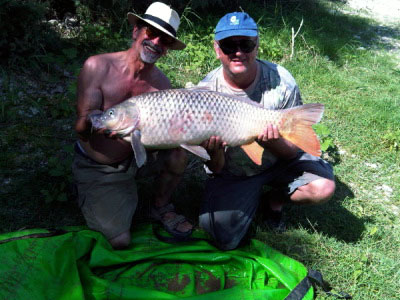 Saturday was a nightmare. Everyone in Spain wanted to fish and most of them wanted to fish in our baited area with a small number of anglers with a huge number of rods crowding our party on either side. Our number of rods had to be cut to four but the fish kept coming. Along with several carp the party took the following: John 39lb, Neil 37lb and a small unweighed single, Dave Steuart a 43lber and Richard continued his livebait snatching spell with two small kittens.
Saturday was a nightmare. Everyone in Spain wanted to fish and most of them wanted to fish in our baited area with a small number of anglers with a huge number of rods crowding our party on either side. Our number of rods had to be cut to four but the fish kept coming. Along with several carp the party took the following: John 39lb, Neil 37lb and a small unweighed single, Dave Steuart a 43lber and Richard continued his livebait snatching spell with two small kittens.
On the final day, the Sunday, Richard’s luck looked like it had gone for good when he lost two fish, one being a big one. Imagine his elation when Lady Luck spun around again and gave him a huge 132lber for being so patient! But that was not the only ton-up fish of the day. Neil too scored again with a 111 lb fish and a 30lber as a side dish. John had three fish that day, a double, a 50lb and a 65lber. Dave Steuart stopped directing the operations for long enough to land three more cats of 62, 63 and another PB at 75lb. And then at 1pm they had to knock off to get to the airport!
So you can see, as the week progressed, the fishing just got better and better. Of our 30 odd catfish, half were caught in the last two days with more and more of the big girls showing up. This was undoubtedly the result of continued heavy baiting. If our party had an extra week I have no doubt the catch rate would have intensified – but we would have needed to take out an extra mortgage each to sustain the baiting. We were using at least 3 or 4 sacks of pellet for each 9-hour session. At E50 per sack, that’s a lot of money and the most bait I have ever used anywhere and in such a short time.
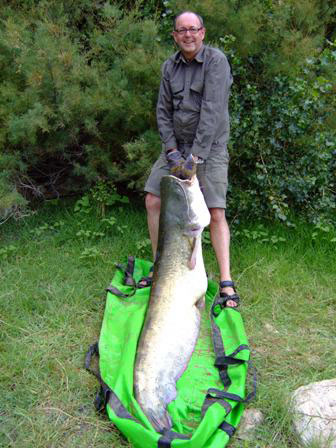
Fishing tips:
- This is the first time I have fished the Ebro with pellets. In the past I always livebaited. Catching fish livebaits can sometimes be difficult though so don’t discount the pellet method. Despite the big price tag it does work very well and if there’s a group of you it is just about affordable.
- When you get a run don’t forget to strike! These are not carp so will not always hook themselves. Watch out for knocks and slack line bites; immediately tighten the line again and feel to see if the fish is still there and if it is, strike!
- You don’t have to trust the guide’s rigs. Check the hooks are sharp and the hooklengths are sound. If in doubt, retie them yourself and ask for fresh hooks. Nobody will mind, they want you to catch fish as much as you do.
- The guides often use a ‘doughnut’ of pellets for a hookbait. We found these to be unreliable, allowing the hooks to turn over and making hooking fish difficult and sometimes impossible. We found using a 5 pellet string tight to the hook gave the best presentation and hookups. I think we missed a lot of fish in our first couple of days to this poor ‘doughnut’ presentation.
- When landing a fish, put your hand into it’s mouth with the palm down, and curl your fingers. You will discover the fish has a natural grab handle to get hold of in the shape of its bottom jaw. Use a glove to stop abrasion from the fish’s tooth-pads
- If you are fishing from the bank absolutely insist the guide provides some shade, usually in the form of a pergola or sunshade gazebo. Just because the guide is used to 30 degrees in direct sun doesn’t mean you are. You are paying the bill so insist on it. These things are a pain to set up but are worth their weight in gold.
A few travel tips:If you want to drive to Spain and take the kitchen sink with you, good luck. Been there and done that. But if you take my advice you will have a much better experience by utilizing one of the catfish holiday/guiding operations and let them take the strain whilst putting you on the fish. The advent of budget airlines have made this the sensible option. If you buy a sensible sized carry on bag, you can save time and money by not needing to check in any luggage. Pack a long sleeved shirt and a hat that will protect your neck. The guiding service can usually collect you at the airport but if you want to have a little more flexibility, cheap car hire is available at either Reus or Zaragosa airports.
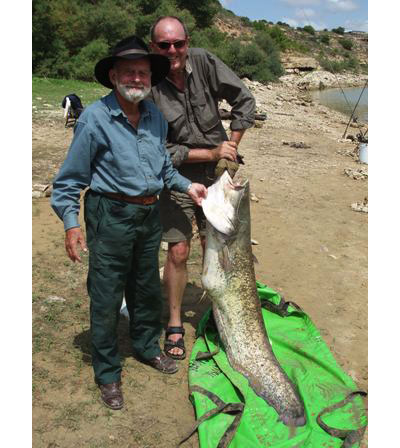 Rules and rumours: the guide service should sort your fishing permit out before you arrive. Expect to have to fax or email a copy of your passport for them to arrange it. Listen to what the guides say but try to get some information from other sources too. The guides often do not speak Spanish and misinterpret translations the same as anyone else. Sometimes deliberately, sometimes accidentally. On my many trips to the Ebro I have been told variously that law forbids the following: Livebaiting, deadbaiting (these from a pellet sales operation) camping, night fishing (from local hotel owners) fishing after dark, bivvies. Also that all catfish must be killed, that a nuclear power station leak has resulted in all fishing to be banned, that rule X applies only in Aragon (and/or Catalonia), that such and such an area has been designated the equivalent of a SSSI, that Mr. Wossname (guide service next door) is operating without a license and going fishing with him will get you arrested. Blah blah blah etc etc yada yada yada. Much of this may be true, was once true or will one day be true. Finding out the actual state of affairs is hard. There’s a minefield of rumour and disinformation as guides try to grab each other’s slice of the pie. Beware of believing all you hear and take most of it with a pinch of salt. Rules do change all the time. If in doubt, get a Spanish speaker to accompany you to the Civil Police and ask them for the facts. Every time I’ve asked a cop, he laughs! So take heart.
Rules and rumours: the guide service should sort your fishing permit out before you arrive. Expect to have to fax or email a copy of your passport for them to arrange it. Listen to what the guides say but try to get some information from other sources too. The guides often do not speak Spanish and misinterpret translations the same as anyone else. Sometimes deliberately, sometimes accidentally. On my many trips to the Ebro I have been told variously that law forbids the following: Livebaiting, deadbaiting (these from a pellet sales operation) camping, night fishing (from local hotel owners) fishing after dark, bivvies. Also that all catfish must be killed, that a nuclear power station leak has resulted in all fishing to be banned, that rule X applies only in Aragon (and/or Catalonia), that such and such an area has been designated the equivalent of a SSSI, that Mr. Wossname (guide service next door) is operating without a license and going fishing with him will get you arrested. Blah blah blah etc etc yada yada yada. Much of this may be true, was once true or will one day be true. Finding out the actual state of affairs is hard. There’s a minefield of rumour and disinformation as guides try to grab each other’s slice of the pie. Beware of believing all you hear and take most of it with a pinch of salt. Rules do change all the time. If in doubt, get a Spanish speaker to accompany you to the Civil Police and ask them for the facts. Every time I’ve asked a cop, he laughs! So take heart.
Have a great trip and catch yourself a monster.
Geoff Maynard
Contacts
Riverside Lodge at Riba Roja (www.riversidelodgespain.com)












